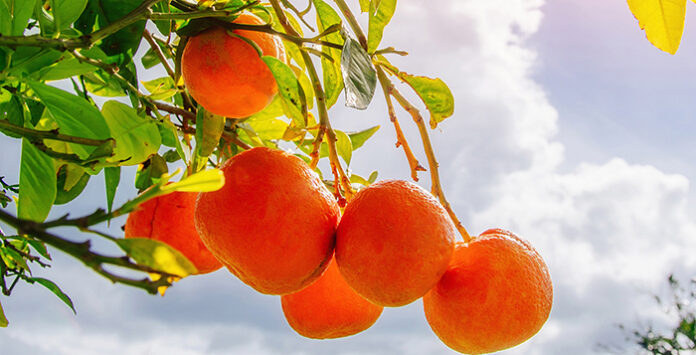By Betty Beeman

Oranges have been a key element in the developing history of Arizona.
Father Eusebio Kino, a missionary from Mexico, reportedly introduced oranges to Arizona in 1707. As Arizona grew with settlers, so did the demand for citrus, primarily oranges and grapefruit.
By 1970 farmers were growing approximately 80,000 acres of citrus in the state. Over time, citrus orchards have mostly been replaced with urban development. However, Yuma County maintains many citrus orchards at present.
Mandarin, navel and Valencia oranges are three of the most popular of the many kinds of citrus available. They have excellent flavor and are mild to the taste and can be eaten or juiced. Some have many seeds, some are hard to peel and some are more tart. The choice is almost overwhelming when you add grapefruits, lemons, limes, tangerines, kumquats and tangelos.
It would help if you could attend a tasting session before purchasing. Greenfield Nursery, in Mesa, has one scheduled Jan. 21. Call for information at 480-830-8000.
In selecting a tree, the trunk should be straight and the tree should support itself without a stake. If at all possible select one with no fruit because you want the energy to go into making new roots rather than making fruit the first year as it adapts to your environment. You can also remove any fruit at time of planting.
Late summer and early fall is a great time to plant citrus because it gives them time to establish a good root system before cold freezing weather comes. You will need to protect your citrus. There are several ways to do this.
Usually straw mulch, cloth covers and even plastic sheeting will protect the tree, because you can lose them to freezing temperatures. My orange and grapefruit trees are about 10 years old, and I do not have to cover them since they are well established.
When choosing your planting site be sure and dig the hole first (twice the size of the rootball or 2 feet wide 2 feet deep), fill with water twice and check for drainage. If the water has not soaked into the ground overnight, pick another site.
[quote_box_right]TIPS
* October is a great month to do your planting. The nurseries are loaded with container-grown plants. Plant artichokes, beets, broccoli, cabbage, carrots, cauliflower, celery, garlic, peas, radishes.
* Right time to divide perennials
* Time to sow wild flowers[/quote_box_right]
Planting the proper depth is very important. Plant too low and the trunk stays wet, encouraging diseases. Plant too high and the rootball will dry out to quickly. If you are unsure, ask the nursery person for advice.
Watering is extremely important. More people kill their trees with too much water rather than too little. Newly planted trees should be watered every seven to 10 days April through September. In the winter, November through February, water every 3-4 weeks, and more often in the summer, of course. You will find watering charts at www.azcitrus.com or www.greenfieldcitrus.com.
Slow, deep watering is the best. Ideally you want to go two to three feet deep. If in doubt, dig down six inches in the soil and feel the soil or get yourself a moisture meter (less than $10). Keep in mind all trees need one to two years to recover from transplanting shock.
Homeowners find citrus is fairly easy to grow and with over 30 varieties to choose from the choice can become very complicated. Citrus trees live long and grow to about 16 feet with a 6-7 foot diameter. They rarely need pruning; they stay green all year and will produce fruit for many years with careful watering and fertilizing.
Questions for Master Gardener volunteers
520 374-6263
[email protected]
MAC-Pinal-MasterGardener.org
Betty Beeman is a resident of Maricopa and a Pinal County Master Gardener.
This column appears in the October issue of InMaricopa.
















![Elena Trails releases home renderings An image of one of 56 elevation renderings submitted to Maricopa's planning department for the Elena Trails subdivison. The developer plans to construct 14 different floor plans, with four elevation styles per plan. [City of Maricopa]](https://www.inmaricopa.com/wp-content/uploads/2024/04/city-041724-elena-trails-rendering-100x70.jpg)

![Affordable apartments planned near ‘Restaurant Row’ A blue square highlights the area of the proposed affordable housing development and "Restaurant Row" sitting south of city hall and the Maricopa Police Department. Preliminary architectural drawings were not yet available. [City of Maricopa]](https://www.inmaricopa.com/wp-content/uploads/2024/04/041724-affordable-housing-project-restaurant-row-100x70.jpg)